Why Do Alpacas Sometimes Show Aggressive Behavior?
You might notice alpacas acting aggressive because they’ve been over-handled or improperly socialized early on. When young alpacas spend too much time with humans instead of their herd, they can develop Aberrant Behavior Syndrome, leading to biting, spitting, or charging. This happens because they misinterpret social cues and boundaries. Ensuring proper herd interactions and setting firm limits early can help prevent these issues. Keep exploring, and you’ll find how to manage and improve their behavior effectively.
Key Takeaways
- Excessive human handling during early growth causes Aberrant Behavior Syndrome, leading to aggression like screaming, biting, and charging.
- Poor socialization with other alpacas disrupts natural boundaries, causing misidentification of humans as herd members and aggressive acts.
- Over-handling and lack of discipline make alpacas view humans as rivals, increasing boundary invasions and aggressive tendencies.
- Mixing male and female alpacas without segregation triggers stress and aggressive behaviors, risking physical harm and reproductive issues.
- Early intervention, consistent discipline, and proper herd integration effectively reduce aggressive behaviors in alpacas.
What Is Aberrant Behavior Syndrome in Alpacas?
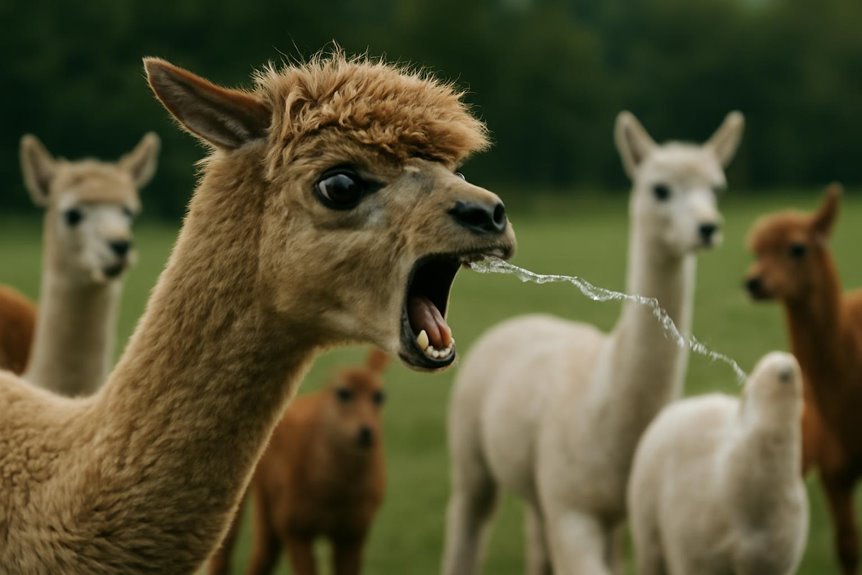
Aberrant Behavior Syndrome (ABS) in alpacas is a serious behavioral disorder caused by improper socialization with their own kind. When alpacas don’t experience proper socialization, often due to excessive human interaction during vital growth periods, they develop Aberrant Behavior Syndrome, leading to aggressive behavior like screaming, spitting, charging, and biting. This disorder isn’t hereditary; instead, it stems from a failure to identify with their species because of human imprinting. You might notice these aggressive behaviors emerge around puberty when hormonal changes heighten their reactions. Understanding that ABS results from disturbed socialization helps you realize why minimizing human contact and encouraging alpacas to bond with one another is essential. Without proper socialization, you risk fostering this dangerous aggressive behavior that compromises both alpacas’ well-being and human safety.
Early Handling and Its Impact on Alpaca Social Skills
When young alpacas are handled too much, especially in their first six months, it can interfere with how they learn to interact with their own kind. This critical period shapes their social skills, and excessive human contact may cause them to misidentify people as fellow alpacas. As a result, these alpacas might display aggressive behavior later on because they don’t understand proper herd dynamics. Over-socialized alpacas, separated early from their mothers and peers, often struggle to respect boundaries, which can lead to frustration and aggression. To prevent this, you should guarantee young alpacas get enough interaction with their herd and establish clear limits during human handling. Proper early socialization helps alpacas develop healthy social skills and reduces the risk of aggressive behavior as they mature.
Recognizing Signs of Aggressive Tendencies
Although alpacas are generally gentle, you should watch for clear signs if they start showing aggressive tendencies. Aggressive behavior often appears as jumping, rearing, or invading your personal space, especially as young animals near breeding age. If an alpaca becomes excessively close, mouths or pulls on your clothing, or suddenly charges and chest bumps, these are red flags. Pay attention to how they respond to contact with humans; an initially enthusiastic alpaca might begin to disrespect boundaries and act aggressively. Early socialization problems, like isolation from peers or too much human contact during youth, can trigger these behaviors. Recognizing these signs early helps you address issues before they escalate, ensuring safer interactions for both you and the alpaca.
How Over-Handling Leads to Aggression
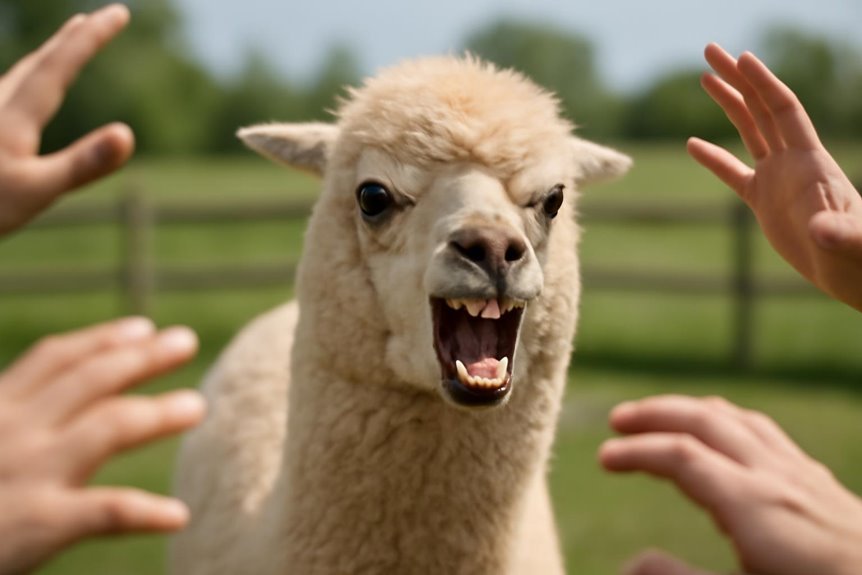
If you handle alpacas too much, especially when they’re young, it can actually cause them to act aggressively. Over-handling young animals often leads to them bonding more with humans than their herd, which disrupts their social development. When young alpacas are bottle-fed and separated from their mothers, they miss critical social cues, increasing the chance of aggressive behavior. Without proper discipline early on, they might not learn boundaries and could start seeing humans as rivals, not caregivers. This lack of socialization and over-friendliness can cause males nearing breeding age to invade personal space and act out aggressively. To prevent this, it’s crucial to balance interaction and guarantee young alpacas develop appropriate social skills within their herd, reducing the risk of aggression as they mature.
The Role of Herd Dynamics in Behavior Regulation
Since alpacas thrive in groups, their behavior is deeply shaped by the herd’s social structure. As herd animals, they rely on a clear social hierarchy to maintain order and reduce stress. Each alpaca has a role, with an alpha leading and influencing others to keep aggressive behaviors in check. If an alpaca is separated or attention is unevenly distributed, social stability breaks down, often causing agitation and increased aggression. Understanding this helps you manage your alpacas better by ensuring they stay in groups of at least three to form a stable hierarchy. Also, separating adult males and females is essential, as mixing them disrupts herd dynamics and can trigger aggressive behaviors, risking harm and reproductive issues. Herd dynamics truly regulate how alpacas behave daily.
Hormonal Changes and Their Effect on Male Alpacas
When male alpacas reach breeding age, you’ll likely notice a surge in aggressive behavior tied to hormonal changes. Testosterone production ramps up, triggering territorial and competitive instincts that can lead to charging, spitting, and sudden aggression. As an alpaca owner, it’s important to recognize that these behaviors aren’t just play but rooted in hormonal fluctuations. Your male alpaca might switch from friendly to hostile quickly, often without warning. If your alpaca was overly socialized with humans early on, distinguishing between herd and human interactions can become confusing, worsening aggression during these periods. Managing these hormonal changes through methods like early castration or careful behavior monitoring can help you minimize risks and maintain safety for both your alpaca and yourself.
Preventing Aggression Through Proper Socialization
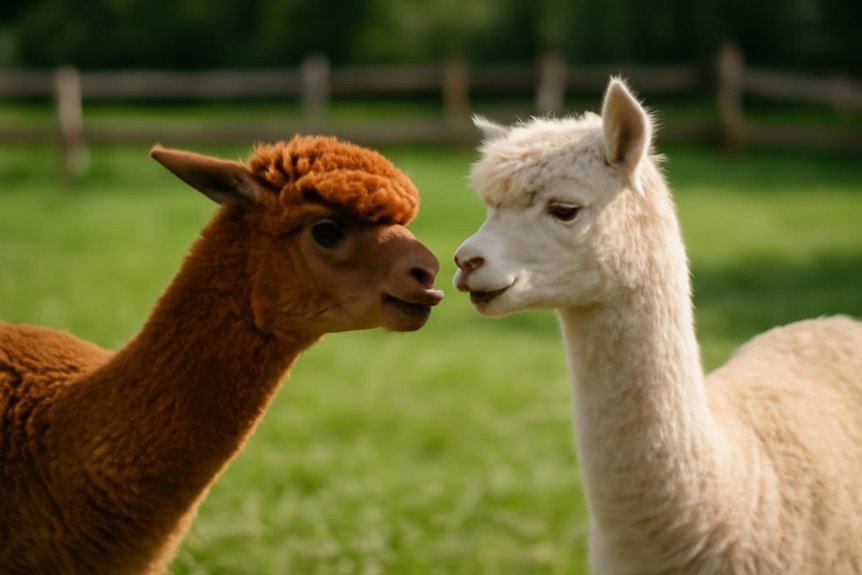
Understanding the hormonal shifts that drive aggression in male alpacas is just one piece of the puzzle. To prevent aggression, proper socialization during the vital first six months is key. You should minimize physical contact, especially excessive cuddling or handling, to avoid creating inappropriate bonds that can lead to aggressive behavior later. Instead, encourage interaction with their herd and limit direct human contact during bottle-feeding. This helps young alpacas develop essential social skills and reduces over-dependence on humans. Providing companionship with other alpacas is essential, as isolation can increase the risk of Aberrant Behavior Syndrome. Consistent training and clear boundaries reinforce positive interactions, ensuring alpacas see you as a caregiver, not a rival. Proper socialization sets the foundation for calm, well-adjusted alpacas.
Discipline Techniques to Manage Aggressive Behavior
Though proper socialization lays the groundwork, you’ll need immediate and consistent discipline to manage any aggressive behavior in your alpacas. Effective discipline techniques help establish clear boundaries and protect personal space. Here’s what you can do:
- Use verbal reprimands or light swats to correct improper behavior instantly.
- Employ water blasters to deter alpacas from invading personal space.
- Monitor behavior regularly to catch signs of escalating aggression early.
- Apply firm, consistent discipline, especially with males nearing breeding age.
- Consider gelding persistent aggressive males as a long-term solution.
The Importance of Gender Segregation in Alpaca Herds
You’ve got to keep male and female alpacas separated to avoid aggressive encounters that can cause serious harm. This separation isn’t just about safety—it also plays an essential role in protecting reproductive health and preventing stress-related pregnancy losses. By maintaining clear gender boundaries, you help create a calmer, healthier herd environment.
Male and Female Separation
Because adult male and female alpacas can pose risks to each other’s health and well-being, keeping them separated is essential. Male and female separation helps maintain balanced herd dynamics and prevents aggressive behaviors that may harm females. When you keep genders apart, you reduce stress and protect pregnancies. Here’s why it’s important:
- Prevents physical harm to females
- Reduces stress and social disruption
- Maintains stable social hierarchy
- Minimizes aggressive interactions during breeding season
- Enables better breeding management
Preventing Physical Harm
When managing an alpaca herd, keeping adult males and females separate is essential to preventing physical harm to the females. Mixing genders can trigger aggressive behavior in males, risking lost pregnancies or even death for females. Gender segregation helps maintain social order by preserving the herd’s hierarchy, which reduces stress and minimizes aggression. You’ll want at least three alpacas in each group to establish a stable social structure, preventing agitation caused by isolation. Disrupting this balance by improper mixing can escalate aggressive behavior, putting females at risk. By understanding and applying gender segregation, you’re directly protecting the health and safety of your alpacas, ensuring a safer environment free from unnecessary physical harm.
Maintaining Reproductive Health
Although it might seem simpler to keep your alpacas mixed, maintaining strict gender segregation is essential for their reproductive health. Mixing males and females often causes aggressive behavior, especially among males competing for breeding rights. To protect your herd, consider these key points:
- Prevent physical harm by separating adult males and females
- Reduce stress and aggression through established social hierarchies
- Avoid lost pregnancies caused by male territorial instincts
- Enhance breeding success with controlled interactions
- Manage herd behavior to minimize aggressive incidents
Case Studies: From Aggressive to Well-Behaved Alpacas
You’ll see how early intervention can turn aggressive alpacas around, especially when behavior modification techniques are used consistently. Socialization plays a huge role in helping these animals adjust and become more manageable. Let’s look at real cases that show how these strategies make a difference.
Early Intervention Success
If you want to transform an aggressive alpaca into a calm and well-behaved member of your herd, early intervention is key. Addressing aggressive behavior promptly through consistent training sessions and socialization can lead to remarkable improvements. You’ll find success by focusing on:
- Early castration and integration with a compatible herd
- Immediate, gentle discipline like verbal reprimands or water blasters
- Regular, structured human interaction balanced with herd time
- Training sessions that reinforce positive social behaviors
- Consistency in redirecting improper actions
These steps help your alpaca understand boundaries and respect, reducing aggression over time. Case studies prove that early intervention not only calms alpacas but also fosters better relationships within the herd and with you, making management easier and your alpaca’s life more enjoyable.
Behavior Modification Techniques
When dealing with aggressive alpacas, starting behavior modification right away can make all the difference. You’ll want to use immediate discipline like verbal reprimands or light swats to correct aggressive behavior as it happens. Training commands such as “no ma’am” are useful tools to curb bad habits over time. Positive human interaction, including gentle handling and consistent routines, helps turn aggressive alpacas into well-behaved members of your herd. Case studies show that early castration and proper socialization within male herds greatly improve behavior. When integrating newcomers, patience and consistent reinforcement are key—alpacas like Faith and Stormy thrived this way. By applying these behavior modification techniques, you can foster a calmer, more respectful group of alpacas that coexist peacefully.
Socialization’s Role
Although socialization might seem straightforward, its role in shaping alpacas’ behavior is critical, especially during their first six months. Proper socialization helps young animals develop healthy herd dynamics and prevents aggressive tendencies. Here’s what you should know:
- Early socialization reduces aggression linked to poor human interaction.
- Case studies like Paolo’s show improved behavior after castration and male herd integration.
- Over-handling can cause Aberrant Behavior Syndrome, leading to aggression.
- Positive reinforcement and consistent discipline effectively modify behavior.
- New herd members, such as Faith and Stormy, benefit from gradual socialization to overcome fear.
Frequently Asked Questions
Why Are Alpacas so Aggressive?
You might think alpacas are just calm creatures, but their aggressive side often hides beneath. It’s tied to herd dynamics and social hierarchy—when stress triggers hit, their natural instincts to protect their place kick in fiercely.
What Is the Angry Alpaca Syndrome?
You should know Angry Alpaca Syndrome is a behavioral disorder where alpacas misinterpret alpaca communication signals due to disrupted herd dynamics influence and environmental stress factors, causing aggressive behaviors that can be dangerous and hard to manage.
How to Tell if an Alpaca Is Angry?
You might notice an angry alpaca’s body language cues—flattened ears, raised tail—just as it defends territory or asserts social hierarchy. These signs warn you it’s feeling threatened or challenged, so it’s best to give space.
Why Are My Alpacas Fighting?
Your alpacas are fighting because of dominance hierarchy struggles and stress factors like new introductions or territorial disputes. These fighting causes help them establish social order, so try separating males and reducing stress to minimize conflicts.

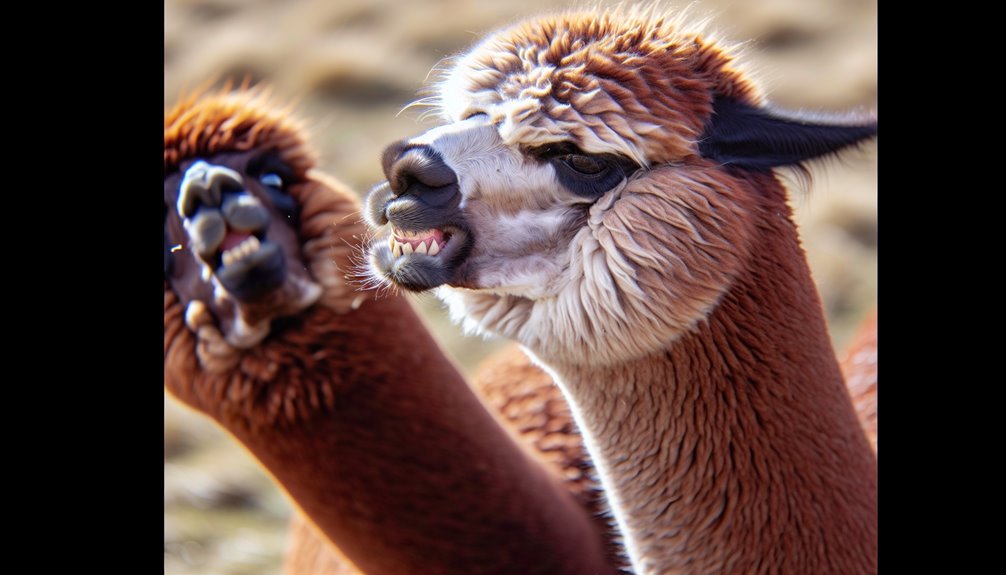

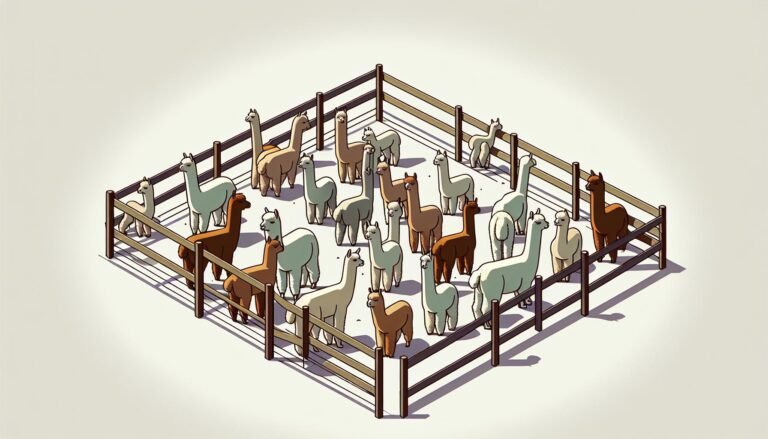
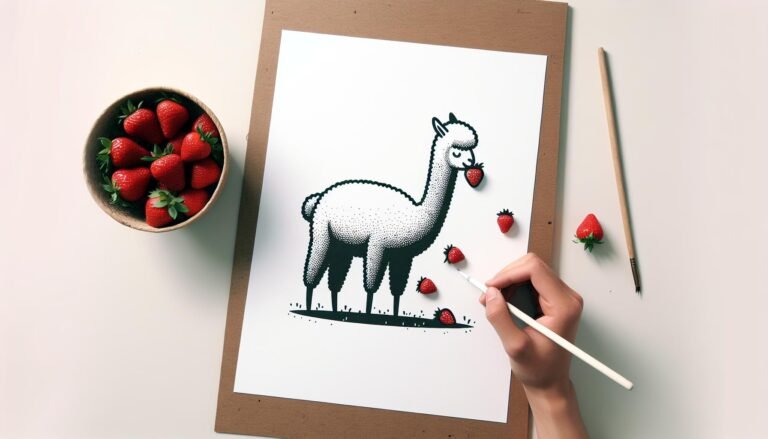
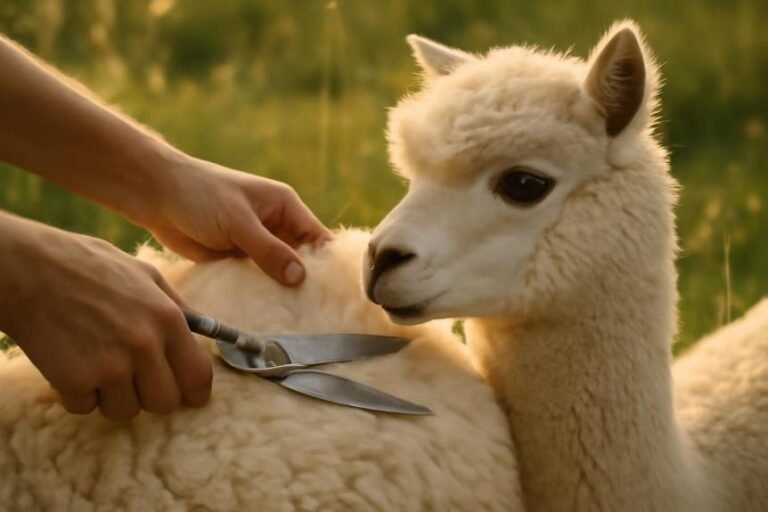
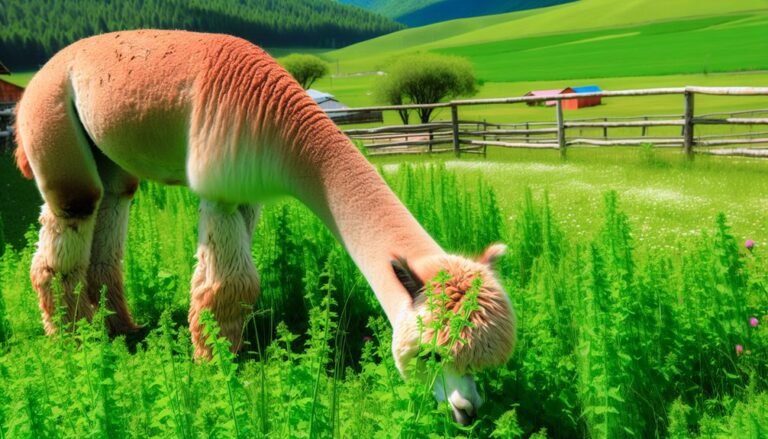

Our picks
Alpaca & Wool Felted Sole Inserts: Comfy Upgrade?
Best Alpaca Socks for Hiking: Ultimate Comfort and Durability on Trails
Best Alpaca Halter for Comfort and Control